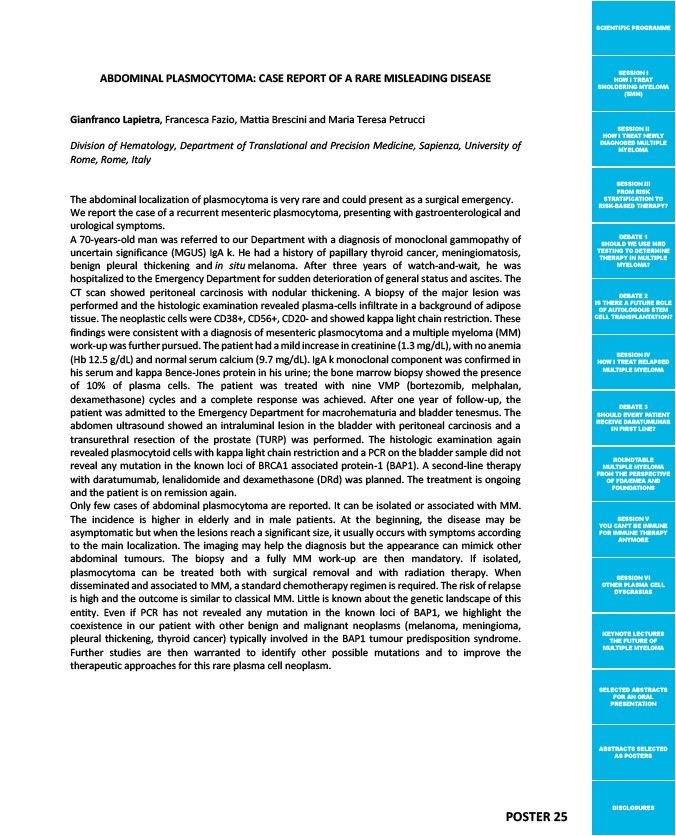
SCIENTIFIC PROGRAMME
SESSION I
HOW I TREAT
SMOLDERING MYELOMA
(SMM)
SESSION II
HOW I TREAT NEWLY
DIAGNOSED MULTIPLE
MYELOMA
SESSION III
FROM RISK
STRATIFICATION TO
RISK-BASED THERAPY?
DEBATE 1
SHOULD WE USE MRD
TESTING TO DETERMINE
THERAPY IN MULTIPLE
MYELOMA?
DEBATE 2
IS THERE A FUTURE ROLE
OF AUTOLOGOUS STEM
CELL TRANSPLANTATION?
SESSION IV
HOW I TREAT RELAPSED
MULTIPLE MYELOMA
DEBATE 3
SHOULD EVERY PATIENT
RECEIVE DARATUMUMAB
IN FIRST LINE?
ROUNDTABLE
MULTIPLE MYELOMA
FROM THE PERSPECTIVE
OF FDA/EMEA AND
FOUNDATIONS
SESSION V
YOU CAN’T BE IMMUNE
FOR IMMUNE THERAPY
ANYMORE
SESSION VI
OTHER PLASMA CELL
DYSCRASIAS
KEYNOTE LECTURES
THE FUTURE OF
MULTIPLE MYELOMA
SELECTED ABSTRACTS
FOR AN ORAL
PRESENTATION
ABSTRACTS SELECTED
AS POSTERS
DISCLOSURES POSTER 25
ABDOMINAL PLASMOCYTOMA: CASE REPORT OF A RARE MISLEADING DISEASE
Gianfranco Lapietra, Francesca Fazio, Mattia Brescini and Maria Teresa Petrucci
Division of Hematology, Department of Translational and Precision Medicine, Sapienza, University of
Rome, Rome, Italy
The abdominal localization of plasmocytoma is very rare and could present as a surgical emergency.
We report the case of a recurrent mesenteric plasmocytoma, presenting with gastroenterological and
urological symptoms.
A 70-years-old man was referred to our Department with a diagnosis of monoclonal gammopathy of
uncertain significance (MGUS) IgA k. He had a history of papillary thyroid cancer, meningiomatosis,
benign pleural thickening and in situ melanoma. After three years of watch-and-wait, he was
hospitalized to the Emergency Department for sudden deterioration of general status and ascites. The
CT scan showed peritoneal carcinosis with nodular thickening. A biopsy of the major lesion was
performed and the histologic examination revealed plasma-cells infiltrate in a background of adipose
tissue. The neoplastic cells were CD38+, CD56+, CD20- and showed kappa light chain restriction. These
findings were consistent with a diagnosis of mesenteric plasmocytoma and a multiple myeloma (MM)
work-up was further pursued. The patient had a mild increase in creatinine (1.3 mg/dL), with no anemia
(Hb 12.5 g/dL) and normal serum calcium (9.7 mg/dL). IgA k monoclonal component was confirmed in
his serum and kappa Bence-Jones protein in his urine; the bone marrow biopsy showed the presence
of 10% of plasma cells. The patient was treated with nine VMP (bortezomib, melphalan,
dexamethasone) cycles and a complete response was achieved. After one year of follow-up, the
patient was admitted to the Emergency Department for macrohematuria and bladder tenesmus. The
abdomen ultrasound showed an intraluminal lesion in the bladder with peritoneal carcinosis and a
transurethral resection of the prostate (TURP) was performed. The histologic examination again
revealed plasmocytoid cells with kappa light chain restriction and a PCR on the bladder sample did not
reveal any mutation in the known loci of BRCA1 associated protein-1 (BAP1). A second-line therapy
with daratumumab, lenalidomide and dexamethasone (DRd) was planned. The treatment is ongoing
and the patient is on remission again.
Only few cases of abdominal plasmocytoma are reported. It can be isolated or associated with MM.
The incidence is higher in elderly and in male patients. At the beginning, the disease may be
asymptomatic but when the lesions reach a significant size, it usually occurs with symptoms according
to the main localization. The imaging may help the diagnosis but the appearance can mimick other
abdominal tumours. The biopsy and a fully MM work-up are then mandatory. If isolated,
plasmocytoma can be treated both with surgical removal and with radiation therapy. When
disseminated and associated to MM, a standard chemotherapy regimen is required. The risk of relapse
is high and the outcome is similar to classical MM. Little is known about the genetic landscape of this
entity. Even if PCR has not revealed any mutation in the known loci of BAP1, we highlight the
coexistence in our patient with other benign and malignant neoplasms (melanoma, meningioma,
pleural thickening, thyroid cancer) typically involved in the BAP1 tumour predisposition syndrome.
Further studies are then warranted to identify other possible mutations and to improve the
therapeutic approaches for this rare plasma cell neoplasm.